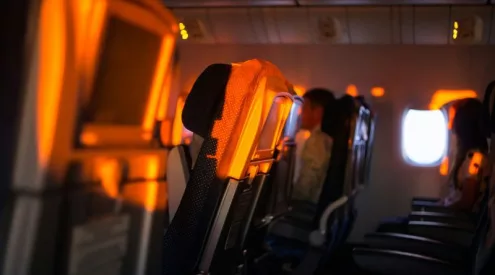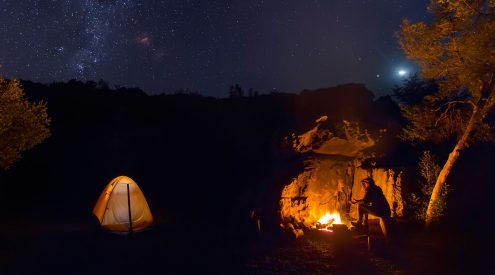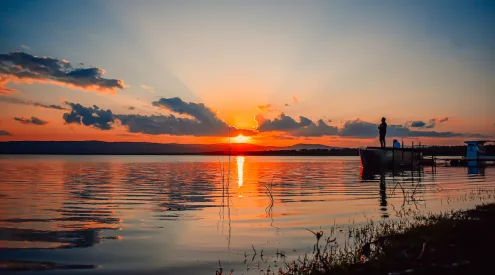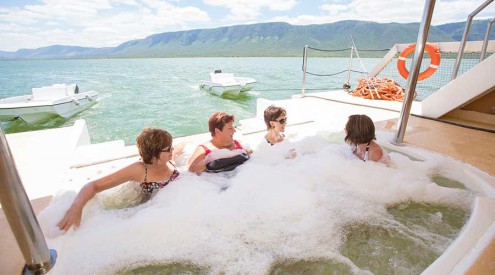Last week I was lucky enough to complete an adventure at the top of my bucket list – mountain gorilla tracking in Rwanda.
It’s not the inaccessible trip that you might imagine to be – rather a four-hour flight to Kigali from Joburg on RwandAir (which has air hostesses who look like models and the best airplane tea ever), and then a three-hour drive through chocolate-coloured hills to the Volcanoes National Park in the northwest of the country. The park forms part of the Virunga Mountains, a chain of active and inactive volcanoes, which span Rwanda, Uganda and the DRC, and, together with the Bwindi Impenetrable Forest in Uganda, around 40 km away, is the only habitat on earth where mountain gorillas (Gorilla berengei berengei) live.
To see the mountain gorillas, you need to buy a permit in advance of your visit from the Rwanda Tourism Board. Permits currently cost $750USD a person, and are set to go up to $1000 a person in 2014, and allow you to spend an hour with a gorilla group.
There are 10 gorillas groups ranging in size from less than 10 individuals to over 40 open to tourists (the remaining seven are observerd only by researchers) on the Rwandan side of the park. Each gorilla group is only exposed to a maximum of tourists for one hour each day. That means that less than 100 people get permits each day. (Note that no children under the age of 15 can go gorilla tracking).

On the day of your gorilla tracking, you meet at the Volcanoes National Park headquarters at around 7am and enjoy a traditional Intore dance performance while sipping much-needed coffee. Then you get assigned your gorilla group and a guide, based on your fitness level. You can opt for a short hike (which can range from 30 minutes to an hour), a medium one (anything from one hour to three hours) or a long one to the large Susa group, which can take the whole day. Your guide will be in contact with trackers in the park who know pretty much where each gorilla group is – so each morning they have a good idea of all the gorillas’ whereabouts.

You then head off into the park with your guide, ready to have what will probably be the most amazing wildlife experience of your life.
To make the most of the ultimate bucket list adventure of gorilla tracking, here are my 10 tips:

1. Be realistic about your fitness level
Rwanda’s already at a high altitude (around 1500 metres about sea level) , and you can hike up to over 3000 metres on steep paths. Be realistic about what you’re able to do. Hikes to the gorilla groups can take anything from half an hour one way to 10 hours. You’ll be placed in a group for the gorilla tracking based on the length of hike you’d like to do – so don’t choose the longest hike if you only exercise once a year, as you’ll slow everyone else down. If you are fit, and can handle hiking at a high altitude then opt for a longer hike – gorillas aside, it’s amazing just to be in the Central African rainforest, amongst moss-covered Hagenia trees, thickets of ferns and dense vegetation in a million shades of green.

2. Do research on gorilla groups before you go
It’s possible to request to see a particular gorilla group (depending on whether you are fit enough to do the hike to get to it). Do research on the gorilla groups in Rwanda and decide if there’s a specific one you’d like to see – for example, a group that’s just had babies.
3. Hire a porter to go gorilla tracking
Near the entrance to the park will be a group of porters. Not only will they carry your bag for you and give you a walking stick (which is really helpful in slippery bits) but they also help you up and down slippery, steep parts of the hike. Even if you don’t mind carrying your own bag, and don’t need help, it’s a good idea to take a porter – most of them are ex-poachers who now make a living from gorilla tourism, so by paying one $10 to carry your bag, you’re supporting both the local community and gorilla conservation.

4. What to wear
The rainforest is full of horrible stinging nettles. It hurts to get stung. Protect yourself by bringing a pair of thick gloves (gardening gloves would be perfect), wearing knee-high hiking gaters, a long-sleeved lightweight shirt and wearing fairly thick pants (although it is quite warm so don’t wear your thermals). In terms of other clothes, you can hike in a pair of running shoes but a comfortable pair of hiking boots (preferably with a high ankle to protect from nettles) would be perfect. It often rains (it is a rainforest, after all) so bring a light rainjacket with a hood. Only take essentials in a small backpack – two bottles of water, maybe a snack if you’re a hungry hiker, camera, hat and sunscreen.

5. What camera to bring
If possible, you should bring three camera bodies with three different lenses – I would recommend a zoom lens, wide angle and an in-between lens or a fixed focal length lens. The gorillas move around, and it’s tricky to change lenses while they’re moving so having different camera bodies is ideal. If you’re more a point-and-shoot-type then make sure your camera is fully charged, and bring extra memory cards just in case!

6. Try and shoot video
You’ll be desperate to get great pics of the gorillas to show friends back home how close you came to these amazing animals. But think about shooting video too. It’s fairly easy video to shoot – you’re close to the gorillas and they don’t move as fast as say, lions. You’ll be glad that you shot a video of this once-in-a-lifetime moment.

7. Practise gorilla etiquette
Don’t forget that you’re encountering mountain gorillas in their habitat – this is not a zoo experience. Respect them, their environment and their behaviour and know that you’re a guest in their world. Having said that, don’t worry about being attacked! Gorillas are not as aggressive as popular culture has made them out to be. While they’re huge (silverbacks can be over 200 kgs) and powerful, gorillas on the whole are gentle and shy creatures. There has never been an incident of a habituated gorilla attacking a tourist. These habituated groups see tourists every single day, so they’re pretty used to us.
Your tracking guide will tell you more about how to behave when you’re in the presence of gorillas but here are some things to keep in mind:
- When you approach gorillas, and while you’re around them, make a grunting sound (your guide will show you how) to reassure them that you are a friend. They may even communicate with you!
- Don’t stare straight into gorillas’ eyes – this can be seen to be aggressive.
- Don’t ever run from a gorilla – if one approaches you just act submissive and crouch down.
- Don’t go gorilla tracking if you’re sick – gorillas are susceptible to human illnesses, and if one gorilla in the group catches flu from you, then the entire group could die.
- If you sneeze or cough, turn your head away from the gorillas so as not to spread your germs.
- Don’t eat or drink in front of gorillas.
- You get very close to the gorillas – within a few metres. Don’t push this though – don’t try and get too close.

8. Go gorilla tracking in dry season
While you can go gorilla tracking in Rwanda year-round, the best time to go is in the dry season, which is from June to September. During the dry season, the ground is drier and dirt roads more accessible. I went in August, and while it didn’t rain hard, it did rain every day and the hiking paths were muddy and slippery. I can imagine that during rainy season it’s much more challenging to hike in the Volcanoes National Park.

9. Make the most of your one hour
You are only allowed one hour with gorillas. This is so that gorilla groups don’t get stressed by too much contact with tourists (to be honest, more than an hour with a bunch of ogling camera-toting tourists would be enough for me, too). Make the most of the hour! It goes by so fast – it really was the shortest hour of my life. While you’ll want to take a thousand photos and shoot video, you also need to take time to just appreciate being in the presence of these animals, without viewing them through your camera.
Apparently, somehow gorillas know when their hour with you is up and they can start changing their behaviour. We were very close to a silverback as our hour had almost ended, and I definitely got a feeling from him that he knew it was up – he plonked himself down on a thicket of nettles, crossed his arms, and looked at us slightly grumpily as if to say ‘Ok, you’ve had your hour of taking photos, now it’s time for you to leave so I can nap in peace.’

10. Read/watch Gorillas in the Mist before you go
The week before I left for Rwanda I rented Gorillas in the Mist, about Dian Fossey’s experience of living with and studying mountain gorillas in the DRC and Rwanda. The film was shot in Rwanda, so you can excited for the beautiful landscapes before you arrive in the country, and get extremely excited about being able to see mountain gorillas (although don’t expect them to hold your hand like they do in the movie with Dian). I wish I had also read Gorillas in the Mist before I’d gone on my gorilla tracking trip – I only read it after my return – it’s a fascinating account of mountain gorillas, with so much more interesting information about Dian Fossey’s studies than the movie.
More of my photos from my gorilla tracking trip in Rwanda.


















